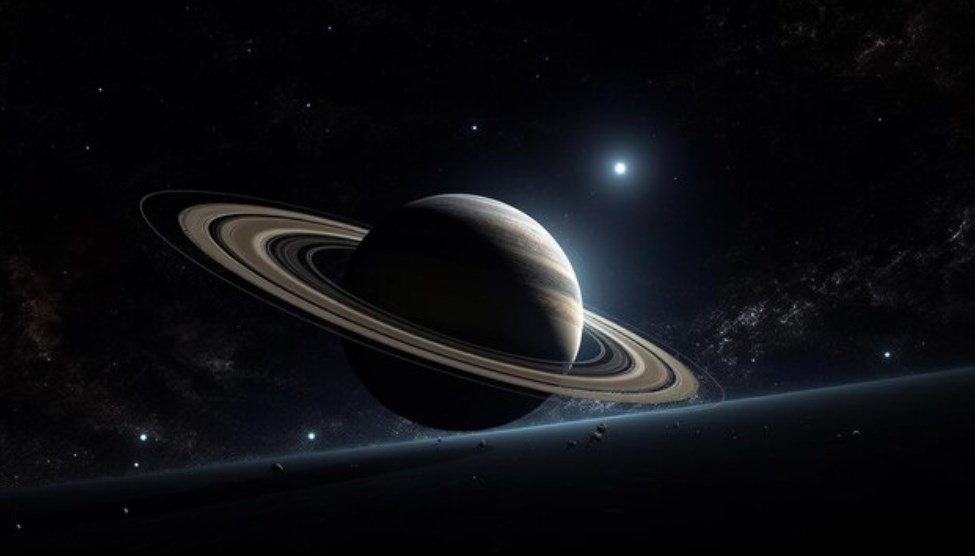Delving into the cosmic wonders of our solar system, this article brings to light fascinating aspects of Saturn, the celestial giant known for its stunning rings and numerous moons. Often captivating astronomers and space enthusiasts, Saturn stands as a testament to the universe’s complexity and beauty.
Here, we unravel the mysteries and lesser-known truths about this awe-inspiring celestial body, offering readers a glimpse into the intricate workings of our solar system’s second-largest planet.
Saturn’s Majestic Rings and Rapid Rotation
- Prominent Ring System: Saturn’s rings, comprised of dust, ice, and rock particles, range from microscopic grains to chunks as large as skyscrapers. This vast ring system, extending nearly the distance between Earth and the Moon, is less than a kilometer thick, showcasing a delicate yet grandiose celestial phenomenon;
- Rapid Rotation: Despite being a gas giant, Saturn completes one rotation on its axis in just about 10.5 hours. The absence of a solid surface makes measuring its rotation challenging, requiring astronomers to rely on the planet’s magnetic field for accurate calculations.
Saturn’s Moons and Mythological Significance
- Diverse Satellite System: With 82 known moons, Saturn boasts the largest moon collection;
- in our solar system. Titan, its largest moon, stands as the second-largest in the solar system, showcasing diverse geological features;
- Mythological and Cultural Impact: The Roman God Saturn, associated with agriculture, lends his name to the planet and the day Saturday, reflecting the planet’s deep-rooted influence in various cultures and mythologies.
Saturn’s Atmospheric Composition and Unique Phenomena
- Gaseous Composition: Dominated by hydrogen and helium, Saturn’s atmosphere contributes to its low density, even lower than water, underscoring its distinct physical properties compared to terrestrial planets;
- Optical Illusions: Saturn’s tilted axis creates unique visual phenomena, where its rings occasionally appear to vanish from our perspective due to their alignment with Earth, adding to the planet’s mystique.
Potential for Extraterrestrial Life
- Enceladus’s Geysers: The discovery of ice geysers on Saturn’s moon Enceladus by NASA’s Cassini spacecraft suggests the presence of liquid water, raising possibilities of life existing in the Saturnian system, beyond Earth.
Saturn’s Influence on Astronomy and Culture
- Astronomical Significance: Saturn has been a pivotal focus in the field of astronomy, inspiring numerous studies and space missions, including the iconic Cassini-Huygens mission;
- Cultural Impact: From ancient mythology to modern-day science fiction, Saturn has captured the imagination of societies worldwide, symbolizing time, change, and the unknown in various cultural narratives.
Technological Advances in Saturn Exploration
- Spacecraft Missions: The exploration of Saturn has been marked by significant technological advancements, with spacecraft like Voyager and Cassini providing unprecedented insights into the planet’s atmosphere, rings, and moons;
- Future Prospects: Emerging technologies and proposed missions promise to further unravel Saturn’s mysteries, potentially revealing more about its composition, weather patterns, and the potential for life on its moons.
Conclusion
This exploration of Saturn has illuminated numerous aspects of this gas giant, from its breathtaking rings and diverse moon system to its cultural and mythological significance. As we continue to unravel the mysteries of the cosmos, Saturn stands as a beacon of wonder, captivating the minds of astronomers, scientists, and enthusiasts alike.
Through technological advancements and persistent curiosity, the enigmatic allure of Saturn will undoubtedly continue to inspire future generations in their quest to understand the universe’s vast and varied wonders.





